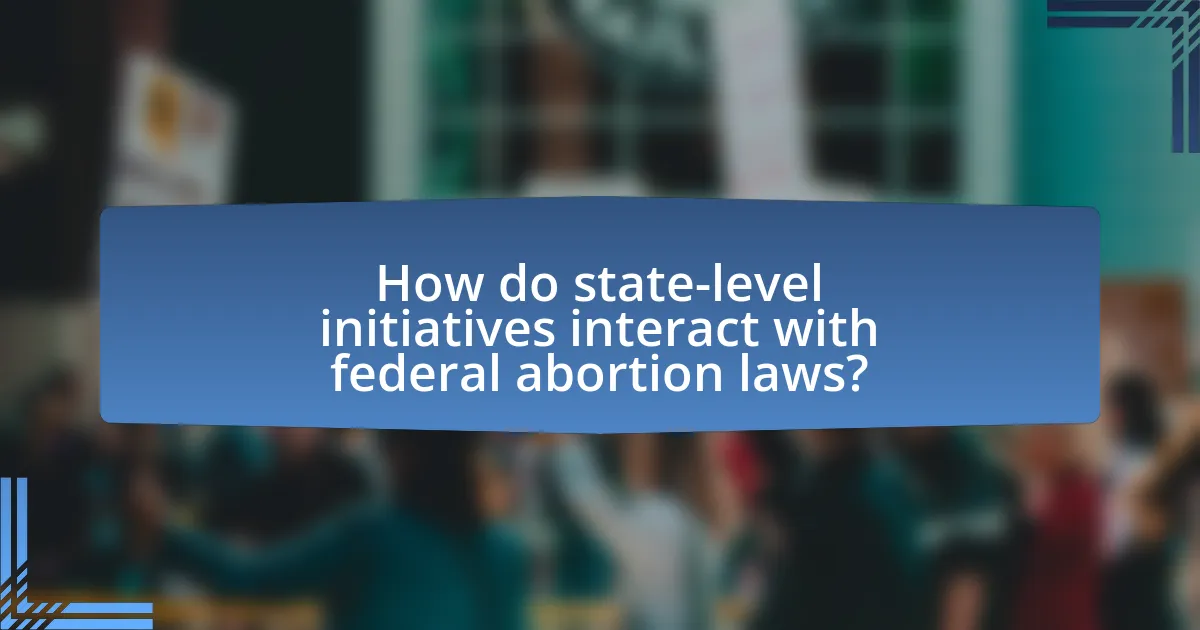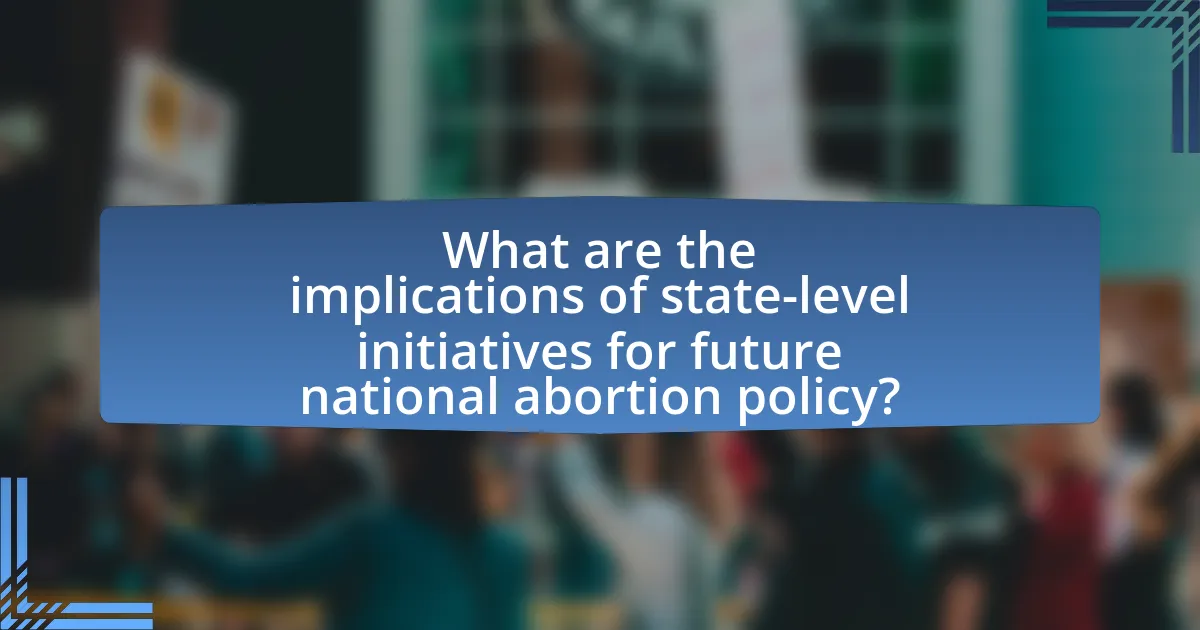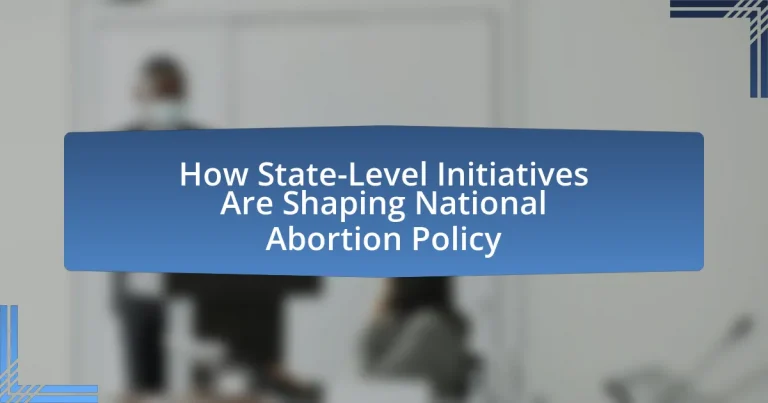State-level initiatives are playing a crucial role in shaping national abortion policy by creating a diverse landscape of laws that reflect regional attitudes and priorities. This article examines how various state-level measures, including restrictive and protective legislation, impact access to abortion services and influence national discourse. It highlights the significance of ballot initiatives, the challenges faced by these measures, and the interaction between state and federal regulations. Additionally, the article discusses the implications of these initiatives for future national policy and the strategies states can adopt to effectively influence legislative outcomes.

How are state-level initiatives influencing national abortion policy?
State-level initiatives are significantly influencing national abortion policy by creating a patchwork of laws that reflect regional attitudes and priorities. For instance, states like Texas and Alabama have enacted restrictive abortion laws, which have prompted legal challenges and discussions at the national level regarding women’s reproductive rights. These initiatives often serve as testing grounds for policies that may be adopted or contested on a broader scale, as seen with the Supreme Court’s consideration of cases stemming from state legislation. The outcomes of these state-level initiatives can lead to shifts in national discourse and policy, as they highlight the varying degrees of access and rights across the country, ultimately shaping the legislative landscape at the federal level.
What types of state-level initiatives are currently being implemented?
State-level initiatives currently being implemented include legislation aimed at restricting or expanding access to abortion services. For example, several states have enacted laws that impose waiting periods, mandatory counseling, and parental consent requirements for minors seeking abortions. Additionally, some states are implementing measures to protect abortion rights, such as codifying Roe v. Wade into state law or providing funding for reproductive health services. These initiatives reflect the ongoing political and social debates surrounding abortion, with states taking varied approaches based on their political climates and public opinion.
How do legislative measures impact access to abortion services?
Legislative measures significantly impact access to abortion services by establishing regulations that can either facilitate or restrict availability. For instance, laws that mandate waiting periods, parental consent, or mandatory counseling can create barriers that delay or prevent individuals from obtaining abortions. According to the Guttmacher Institute, states with more restrictive abortion laws often see a decrease in the number of clinics and services available, leading to increased travel distances and costs for individuals seeking care. Conversely, states that enact protective measures, such as ensuring insurance coverage for abortion services, tend to maintain or expand access. This dynamic illustrates how state-level legislative actions directly shape the accessibility of abortion services across the nation.
What role do ballot initiatives play in shaping abortion policy?
Ballot initiatives serve as a direct mechanism for citizens to influence abortion policy by allowing voters to propose or reject legislation through a referendum process. This participatory approach enables constituents to express their views on abortion rights and regulations, often reflecting the prevailing public sentiment in a state. For instance, in 2022, voters in California, Michigan, and Vermont approved measures to protect abortion rights, demonstrating how ballot initiatives can effectively shape state laws and, by extension, influence national discourse on abortion policy. These initiatives can lead to significant legal changes, as seen in states where restrictive measures were overturned or protective measures were enacted through voter approval.
Why are state-level initiatives significant in the context of national policy?
State-level initiatives are significant in the context of national policy because they serve as testing grounds for new ideas and approaches that can influence broader legislative changes. For instance, states like Texas and California have enacted distinct abortion laws that reflect varying public opinions and political climates, which can prompt national discussions and potential policy shifts. These initiatives often highlight the diverse needs and values of different populations, demonstrating how localized governance can impact national debates and lead to changes in federal policy, as seen in the evolving landscape of abortion rights following state-level actions.
How do state policies reflect the values and beliefs of their populations?
State policies reflect the values and beliefs of their populations by aligning legislative actions with the prevailing social attitudes and cultural norms of the community. For instance, states with strong pro-choice sentiments often enact laws that protect access to abortion services, while states with significant anti-abortion beliefs may implement restrictive measures. This alignment is evidenced by the variation in abortion laws across the United States; for example, as of 2023, states like California and New York have enacted laws to safeguard reproductive rights, reflecting their populations’ progressive values, whereas states such as Texas and Alabama have passed stringent abortion restrictions, mirroring conservative beliefs. These legislative differences illustrate how state policies serve as a direct manifestation of the collective values and beliefs held by their constituents.
What historical events have led to the current state-level initiatives?
The historical events that have led to current state-level initiatives regarding abortion policy include the 1973 Supreme Court decision in Roe v. Wade, which legalized abortion nationwide, and subsequent legal and political developments that have challenged this ruling. Following Roe v. Wade, various states enacted laws to either protect or restrict access to abortion, reflecting differing political and social attitudes. The 1992 Supreme Court case Planned Parenthood v. Casey upheld Roe but allowed states to impose certain restrictions, leading to a wave of state-level initiatives aimed at regulating abortion access. More recently, the 2022 Supreme Court decision in Dobbs v. Jackson Women’s Health Organization overturned Roe v. Wade, granting states the authority to set their own abortion laws, which has resulted in a significant increase in state-level initiatives either expanding or limiting abortion access across the country.
What challenges do state-level initiatives face in influencing national policy?
State-level initiatives face significant challenges in influencing national policy, primarily due to legal limitations, political opposition, and resource disparities. Legal limitations arise from the U.S. Constitution, which grants states certain powers but reserves others for the federal government, making it difficult for state initiatives to create binding national changes. Political opposition is prevalent, as national lawmakers may resist state-led reforms that conflict with their agendas or party lines, particularly on contentious issues like abortion. Additionally, resource disparities hinder state initiatives, as states with fewer financial and organizational resources struggle to mount effective campaigns that can compete with well-funded national organizations. These factors collectively impede the ability of state-level initiatives to effectuate meaningful changes at the national level.
How do legal battles affect the implementation of state initiatives?
Legal battles significantly hinder the implementation of state initiatives by creating delays and uncertainties in their enforcement. For instance, when a state initiative is challenged in court, the legal proceedings can result in temporary injunctions that pause the initiative’s effects until a final ruling is made. This was evident in the case of various abortion laws enacted in states like Texas and Alabama, where legal challenges led to prolonged periods of uncertainty regarding their enforcement, impacting access to abortion services. Additionally, the outcomes of these legal battles can lead to changes or reversals of the initiatives, as seen in the Supreme Court’s decisions that have influenced state-level abortion policies, thereby shaping the broader national landscape.
What opposition do these initiatives encounter from various stakeholders?
State-level initiatives on abortion policy encounter significant opposition from various stakeholders, including advocacy groups, political parties, and healthcare providers. Advocacy groups such as Planned Parenthood and the American Civil Liberties Union argue that these initiatives infringe on women’s reproductive rights and access to healthcare. Political parties, particularly Democrats, often oppose restrictive measures, citing concerns over women’s autonomy and public health implications. Healthcare providers express opposition due to the potential for increased legal liabilities and the impact on patient care, emphasizing that restrictive laws can lead to unsafe medical practices. These stakeholders collectively highlight the broader implications of state-level initiatives on national abortion policy, emphasizing the need for a balanced approach that considers women’s rights and health outcomes.

How do state-level initiatives interact with federal abortion laws?
State-level initiatives can either complement or conflict with federal abortion laws, depending on the specific regulations enacted by each state. For instance, after the Supreme Court’s decision in Dobbs v. Jackson Women’s Health Organization in 2022, which overturned Roe v. Wade, many states enacted laws that either restricted or expanded access to abortion services. States like Texas implemented stringent restrictions, while others like California and New York moved to protect and expand abortion rights. This dynamic illustrates how state initiatives can directly influence the accessibility of abortion services, often creating a patchwork of laws across the country that reflects local political and social attitudes.
What is the relationship between state and federal abortion regulations?
The relationship between state and federal abortion regulations is characterized by a division of authority, where states have the power to enact their own laws within the framework established by federal law. The U.S. Supreme Court’s decision in Roe v. Wade (1973) initially set a federal standard protecting the right to abortion, but subsequent rulings, such as Planned Parenthood v. Casey (1992), allowed states to impose certain restrictions as long as they do not place an “undue burden” on the right to access abortion. This has led to a patchwork of state laws that vary significantly, with some states enacting more restrictive measures and others protecting access to abortion services, thereby shaping the national abortion policy landscape.
How do state initiatives challenge or support federal laws?
State initiatives can challenge federal laws by enacting legislation that contradicts or undermines federal policies, particularly in areas like abortion where states may adopt more restrictive measures than those allowed at the federal level. For example, several states have passed laws that impose stricter regulations on abortion access, directly opposing the protections established by the Supreme Court’s Roe v. Wade decision. Conversely, state initiatives can also support federal laws by implementing programs that align with federal objectives, such as expanding access to reproductive health services in compliance with federal guidelines. This duality illustrates the complex interplay between state and federal authority, where state actions can either reinforce or obstruct federal legal frameworks.
What legal precedents influence the interaction between state and federal policies?
Legal precedents that influence the interaction between state and federal policies include the Supreme Court cases of McCulloch v. Maryland (1819) and United States v. Lopez (1995). McCulloch v. Maryland established the principle of federal supremacy, affirming that federal laws take precedence over state laws when there is a conflict, which is crucial in areas like abortion policy where states may enact laws that challenge federal standards. Conversely, United States v. Lopez limited the scope of federal power under the Commerce Clause, reinforcing states’ rights to regulate certain issues independently, thereby allowing states to implement their own abortion regulations without federal interference. These cases illustrate the ongoing balance and tension between state and federal authority in shaping policies, including those related to abortion.
How do changes in federal administration impact state-level initiatives?
Changes in federal administration significantly impact state-level initiatives by altering funding, regulatory frameworks, and policy priorities. For instance, when a federal administration supportive of abortion rights is in power, states may receive increased funding for reproductive health services and face less restrictive federal regulations, enabling them to implement more progressive initiatives. Conversely, a federal administration that opposes abortion can lead to reduced funding and stricter regulations, compelling states to either limit their initiatives or seek alternative funding sources. Historical examples include the shift in federal support for Planned Parenthood under different administrations, which directly influenced state-level access to reproductive health services and abortion policies.
What shifts have occurred in federal policy that affect state initiatives?
Recent shifts in federal policy affecting state initiatives include the Supreme Court’s decision in Dobbs v. Jackson Women’s Health Organization, which overturned Roe v. Wade, thereby granting states the authority to regulate abortion laws independently. This ruling has led to a patchwork of state laws, with some states enacting restrictive measures while others have moved to protect abortion rights. Additionally, federal funding policies have changed, impacting how states can allocate resources for reproductive health services, further influencing state-level decisions on abortion access.
How do state leaders respond to changes in federal abortion policy?
State leaders respond to changes in federal abortion policy by enacting legislation that either aligns with or opposes federal directives. For instance, following the U.S. Supreme Court’s decision in Dobbs v. Jackson Women’s Health Organization in 2022, which overturned Roe v. Wade, many state leaders in conservative states moved quickly to implement stricter abortion laws, while leaders in liberal states sought to protect and expand access to abortion services. This divergence illustrates how state leaders actively shape abortion policy in response to federal changes, reflecting their political ideologies and the preferences of their constituents.

What are the implications of state-level initiatives for future national abortion policy?
State-level initiatives significantly influence future national abortion policy by creating a patchwork of laws that reflect regional values and priorities. These initiatives can lead to increased polarization, as states adopt either restrictive or protective measures regarding abortion access, which may prompt federal responses to standardize regulations. For instance, following the Supreme Court’s decision in Dobbs v. Jackson Women’s Health Organization, several states enacted laws that either severely limit or expand abortion rights, demonstrating how state actions can pressure national discourse and legislative efforts. Additionally, public opinion shifts in states, as seen in states where abortion rights are protected, can catalyze national movements advocating for comprehensive federal legislation, thereby shaping the overall landscape of abortion policy in the United States.
How might current trends in state initiatives shape future legislation?
Current trends in state initiatives, particularly regarding abortion policies, are likely to significantly influence future legislation at both state and federal levels. For instance, states that have enacted restrictive abortion laws, such as Texas with its Senate Bill 8, have prompted legal challenges and discussions about reproductive rights, which may lead to a reevaluation of federal standards. Additionally, states that have expanded access to abortion services, like California, are setting precedents that could encourage similar legislative efforts elsewhere. These contrasting approaches highlight a growing polarization that may compel Congress to address abortion policy more comprehensively, potentially resulting in new federal regulations or protections. The ongoing legal battles and public discourse surrounding these state initiatives serve as a catalyst for future legislative action, reflecting the evolving landscape of reproductive rights in the United States.
What potential outcomes can arise from the ongoing state-level initiatives?
Ongoing state-level initiatives can lead to significant changes in national abortion policy, including variations in access to abortion services, shifts in public opinion, and potential legal challenges. For instance, states that implement restrictive abortion laws may see a decrease in the number of clinics available, which can limit access for individuals seeking these services. Additionally, these initiatives can influence national discourse, as public reactions to state laws may prompt federal legislative responses or judicial reviews. Historical examples, such as the differing abortion laws across states following the 1973 Roe v. Wade decision, illustrate how state actions can shape broader national policies and legal frameworks.
How do public opinions influence the direction of future policies?
Public opinions significantly influence the direction of future policies by shaping the priorities and actions of policymakers. When a substantial portion of the public expresses strong views on issues, such as abortion, elected officials often respond to these sentiments to secure votes and maintain public support. For instance, polling data from organizations like Gallup shows that shifts in public opinion regarding abortion rights have led to legislative changes in various states, reflecting the electorate’s preferences. This responsiveness is evident in the increasing number of states enacting laws that align with the prevailing public attitudes on abortion, demonstrating how public sentiment can directly impact policy formulation and implementation.
What best practices can states adopt to effectively influence national policy?
States can effectively influence national policy by leveraging coordinated advocacy, data-driven approaches, and strategic partnerships. Coordinated advocacy involves uniting various stakeholders, including legislators, interest groups, and constituents, to present a unified front on specific issues, thereby amplifying their message and increasing visibility. Data-driven approaches, such as utilizing research and statistics to support policy proposals, can enhance credibility and persuade national lawmakers by demonstrating the impact of state-level initiatives. Strategic partnerships with organizations that have national reach can also help states gain access to broader networks and resources, facilitating the dissemination of their policy goals. For instance, states that have successfully influenced national abortion policy often collaborate with national reproductive rights organizations to align their state initiatives with broader national objectives, thereby increasing their effectiveness.
How can states collaborate to strengthen their initiatives?
States can collaborate to strengthen their initiatives by sharing best practices, pooling resources, and coordinating policy efforts. For instance, states can establish inter-state coalitions focused on specific issues, such as reproductive health, to align their strategies and amplify their impact. Research indicates that collaborative networks can lead to more effective policy implementation, as seen in the National Governors Association’s initiatives, which have successfully fostered partnerships among states to address common challenges. By leveraging collective expertise and resources, states can enhance their individual initiatives and create a more cohesive approach to national abortion policy.
What strategies can advocates use to promote successful state-level initiatives?
Advocates can promote successful state-level initiatives by employing grassroots mobilization, coalition building, and strategic communication. Grassroots mobilization involves engaging community members to raise awareness and support for initiatives, which can be evidenced by the success of campaigns like the 2018 ballot initiative in California that aimed to expand access to reproductive health services. Coalition building allows advocates to unite various organizations and stakeholders, enhancing their influence and resources; for instance, the collaboration between reproductive rights groups and healthcare providers has strengthened advocacy efforts in multiple states. Strategic communication focuses on effectively conveying messages through various media channels, which has been shown to sway public opinion and garner support, as seen in the successful messaging strategies used during the 2020 election cycle regarding abortion rights.

